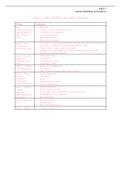Samenvatting
Summary M&S3 Airport Modelling and Analysis
- Vak
- M&S (M&S)
- Instelling
- Hogeschool Van Amsterdam (HvA)
It is a summary of the theoretical part of M&S3 Airport Modelling and Analysis. It shows the theoretical knowledge needed to pass that part of the exam.
[Meer zien]




